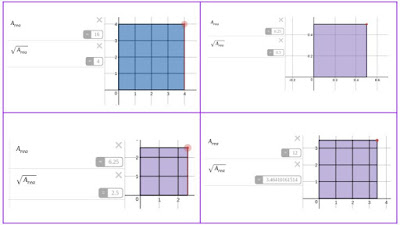Feeling both excited (because I love exploring conceptual understanding and visual representations) and confused (because I wasn't entirely sure what I was looking at), I knew I had to use these in class. I did not end up doing the clothesline activity. What I did instead was start by showing my students a perfect square picture.
We have used squares to discuss exponents, so my students quickly saw that this represents the square root of nine. Square root is the inverse of squaring, therefore if you take the square root of 9 you get the side length of the square, which is 3. After showing the perfect square picture I put up this one:
I simply asked, "If the last one was the square root of nine, what number is this the square root of?" Every student had estimated a decimal number (Why wouldn't they? It sure looks like it won't be a whole number.) Then I told them it was a whole number. There were surprised and now were in the same place I was with this representation. We all needed to explore what was happening. I told them it was 12 and let them discuss and process this information with their teams. In the past, for numbers like the square root of 12, I would use an open square and put the answer, ~3.464, on the side of the square. The difference with this visual is that the square is divided into unit squares.
- The small rectangular pieces are ~0.464 x 1
- The tiny square is ~0.464 x ~0.464
- All the pieces added together equals 12.
Students don't need to be able to look at a square like the one above and know what whole number it represents. The purpose of the visual for the clothesline is for students to understand the relative size compared to the perfect squares and where they would fall on a number line. I will probably do the clothesline activity yet this year.
After our class discussion, I was tweeting the highlights from my week and the visual of the square root of 12 was one of them.
There was a lot of activity on that tweet and one of them was this:
Followed by this one:
First, let me say I love my PLN. This is why I am a part of #MTBoS. This misconception had never occurred to me and I definitely want to go back to class and check in. All of the squares on Andrew's clothesline are either perfect squares or irrational, which is just fine for that activity. It is important, however, in our class discussions to have some examples with partial squares that are not irrational. Luckily, Andrew made a Desmos activity to go along with the clothesline activity so I was able to easily create this one for the square root of 6.25. The rectangle pieces are 0.5 x 1 and the small square is 0.5 x 0.5.
To help facilitate these conversations, should you choose to have them (and for myself in the future), I put together a few starting points using some of my favorite conversation starters.
If there are partial squares it is [always, sometimes, never] an irrational number.
I took one slide of Andrew's Desmos activity and made it its own activity so students can explore this and decide for themselves. Students can see the area and square roots in the activity, which will help them analyze and decide.
Notice/Wonder
You could also start with the visual representation in Desmos and simply ask, "What do you notice? What do you wonder?" I recently discovered (thanks to Sara VanDerWerf) if you tell them to, "notice until I tell you to stop", you will have more (often better) launching points for class discussions. You would want to modify the Desmos activity to not have the always, sometimes, never question with it.
Which One Doesn't Belong
Take a minute to play it yourself before you read my notes. These pictures were created in Andrew's Desmos activity and could easily be changed if you wanted something different. Only one of them is an irrational number. Can you tell which one? I also decided to add one where the square root is bigger than the area. Wait, what?! How does that even happen? There are so many possible discussions that could come out of this WODB I am gitty with excitement.
I realize that there is a lot to take in here, especially if it is the first time you are seeing this visual representation. Please feel free to leave comments below. I would love to hear about your thoughts, questions, or any class discussions you have with this visual representation of squares and square roots.






This is great, so much to think about! Thank you for posting :-)
ReplyDeleteYou are welcome. Hope you were able to try some of these with students. I'd love to hear about it if you did.
DeleteVery nice explanation, I've learnt square roots with no basic knowledge... Now it make sense... ;)
ReplyDelete